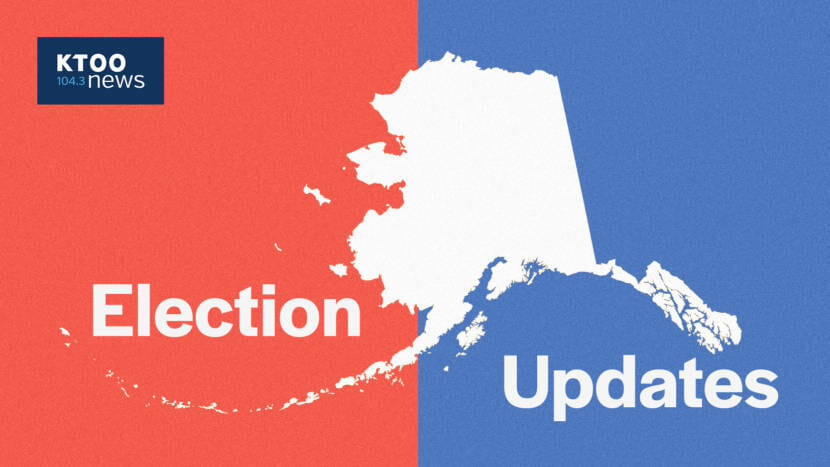
The KTOO News Department will be updating this post with the latest election coverage. Check back for updates, and learn how we plan to get you timely, fair and accurate news on Election Day here.
Alaska has more than 133,000 ballots left to count, but no one knows exactly what that means — Wednesday, Nov. 4., 6:20 p.m.
By Nat Herz, Alaska Public Media
Longtime Anchorage Democratic Senator Bill Wielechowski woke up the morning after Election Day trailing his Republican challenger by more than 200 votes. But does he have any anxiety about it? Not really.
“I have no doubt that when it’s done, I’m going to win by a significant margin,” he said.
Voters cast about six thousand ballots in Wielechowski’s district on Election Day. But thousands more votes won’t be counted until next week at the earliest — part of a blizzard of early and absentee ballots that Alaskans voted this year, largely in response to the COVID-19 pandemic.
Political observers say they expect the uncounted absentee and early ballots to skew more strongly toward Democratic and independents since Republicans were more likely to vote in-person amid the pandemic. And Wielechowski says he expects those uncounted ballots to put a number of trailing Democratic candidates ahead of their rivals.
“I know people are freaking out, on the Democratic side — some people. But you literally counted the Republican ballots last night and you’re going to count the Democratic ballots next week. And you’re going to see change,” he said.
The big question is just how much change.
Read the full story here.
Some Alaska Republicans build large leads through Wednesday’s vote count, with counting to resume in a week — Wednesday, Nov., 4 5:42 p.m.
By Andrew Kitchenman, KTOO and Alaska Public Media
Alaska Republican candidates up and down the ballot built large leads in Election Day results. And both ballot measures — which were opposed by most Republican politicians — also trailed by significant amounts. But with more than 40 percent of the ballots left to be counted, the outcomes of several hotly contested races remained unknown.
Republican President Donald Trump is currently leading in Alaska by 28% of the 192,918 ballots counted through Wednesday afternoon.
U.S. Sen. Dan Sullivan is leading in his race against Al Gross by 30%, and U.S. Rep. Don Young in his race against Alyse Galvin by 26%.
But more than 133,000 absentee and early votes remain to be counted next week. And the state Division of Elections is still adding absentee ballots that were postmarked by Election Day to that total.
Read the full story here.
With thousands of votes still uncounted, Alaska’s initial results show many Republicans ahead — Tuesday, Nov. 4, 2020, 1:10 a.m.
By Rashah McChesney, KTOO and Casey Grove, Alaska Public Media
With many ballots still to be counted, some races have started to take shape after early results in Alaska’s Election Day tally.
With nearly 70% of precincts reporting, the state’s Division of Elections updated results a little before 1 a.m. Wednesday, showing a total of about 157,0000 votes cast statewide. With increased absentee by mail votes amid the COVID-19 pandemic, more than 120,000 early absentee votes remain to be counted in a week, starting on Nov. 10.
Republicans lead at the top of the ballot, as Alaskans have so far favored President Donald Trump, incumbent U.S. Sen. Dan Sullivan and longtime Congressman Don Young, each with more than 60 percent of the vote in their respective races.
The early count shows voters rejecting both initiatives on the ballot.
Ballot Measure 1, aimed at changing state oil taxes, was down with nearly 65% of votes cast against it. It would have to get “yes” votes on more than 65% of remaining ballots to overcome the gap.
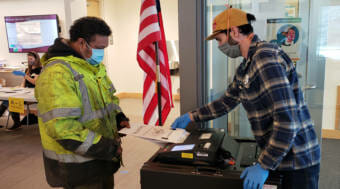
And Ballot Measure 2, which would overhaul the state’s elections, was failing with “no” votes amounting to nearly 57%When the remaining votes are counted, Ballot Measure 2 would need to take more than 56% of them in order to pass.
Some of the races that could determine who controls the Alaska House and Senate are also starting to come into focus.
The state House currently has 23 Republicans, and it takes 21 seats to control the chamber. The Senate has 13 Republicans; 11 seats are needed to control it.
Several incumbent Democrats in the Alaska Legislature were behind Tuesday night.
- Fairbanks’ District 5 state Rep. Adam Wool trailed Republican challenger Kevin McKinley slightly, 48% to 52%.
- Anchorage Rep. Ivy Spohnholz was behind Republican challenger Paul Bauer 52-40%, with Libertarian Scott Kohlhaas taking nearly 9% of the votes.
- Anchorage Rep. Chris Tuck is trailing Republican challenger Kathy Hensley who holds nearly 52% of the vote. Alaska Independence Party candidate Timothy Huitt has drawn just under 10% of the vote in that race.
- Anchorage Sen. Bill Wielechowski was behind Republican challenger Madeleine Gaiser, who took a little more than 51%.
Initial results showed Supreme Court Justice Susan Carney overcoming a conservative coalition’s campaign against her, with 57% of voters favoring her retention.
These are preliminary results, and, as Alaska is the last state in the country to begin to count absentee ballots, the outcome of close races won’t be known for at least a week after Election Day.
More results roll in for Alaska House and Senate races, ballot measures — Tuesday, Nov. 3, 2020, 11:20 p.m.
By Rashah McChesney, KTOO and Casey Grove, Alaska Public Media
Some of the races that could determine who controls the Alaska House and Senate are starting to take shape.
With nearly 46% of precincts tallied, the state’s Division of Elections updated results a little before 11 p.m.
The state House currently has 23 Republicans, and it takes 21 seats to control the chamber. The Senate has 13 Republicans, 11 seats are needed to control it.
In the House, Republican lawmaker Gabrielle LeDoux lost her August primary to 23-year-old David Nelson. On Election Day, Nelson holds a lead of 59-40% over Lyn Franks in that House District 15 race. So far, 60% of the precincts in that district have reported results.
Another longtime lawmaker Democrat Chris Tuck from Anchorage is trailing Republican challenger Kathy Hensley who holds nearly 52% of the vote. Alaska Independence Party candidate Timothy Huitt has drawn just under 10% of the vote in that race.
The early results showed Fairbanks’ District 5 incumbent Democrat state Rep. Adam Wool trailing Republican challenger Kevin McKinley slightly, 48% to 52%.
Two years ago, Wool beat McKinley by a slim margin.
With more than 88% of votes returned in Fairbanks House District 1, Republican Bart Lebon leads over Democratic challenger Christopher Quist.
And in House District 16, incumbent Democrat Ivy Spohnholz is trailing behind Republican Paul Bauer 49-42%. Libertarian Scott Kohlhaas has nearly 9% of the votes.
In the Senate, current Senate President Cathy Giessel lost her primary to Republican Roger Holland. He faces off against Democratic candidate Carl Johnson and Libertarian Carolyn Clift. In that race, with just over 52% of precincts reported, Holland is in the lead with nearly 55% of the vote.
In Fairbanks Senate District B where nearly 75% of precincts have reported, another longtime Republican senator, John Coghill, lost his primary to Republican Robert Myers. Preliminary results show Myers has a comfortable lead over challenger Independent Marna Sanford.
And with half of the precincts reporting in Senate District H, Democratic incumbent Bill Wielechowski is trailing behind Republican challenger Madeleine Gaiser.
In the national races, with nearly half of all precincts reporting, President Donald Trump still leads in the state, drawing nearly 61% of the vote so far.
Sen. Dan Sullivan leads over challenger Al Gross with nearly 61% of the votes so far as does Rep. Don Young over challenger Alyse Galvin.
And early results show oil tax initiative Ballot Measure 1 — dubbed the “Fair Share Act” by its sponsors — is currently down with over 63% of the votes reported cast against it.
No votes on Ballot Measure 2 hold a slight lead over people voting in favor of it. That ballot measure would overhaul the state’s elections.
It’s important to remember that these are preliminary results, and because Alaska is the last state in the country to begin to count absentee ballots, the outcome of close races won’t be known for at least a week after Election Day.
First results released for state elections — Tuesday, Nov. 3, 2020, 9:55 p.m.
By Rashah McChesney, KTOO and Casey Grove, Alaska Public Media
Early results from the Alaska Division of Elections rolled in a little after 9 p.m. with just under 30% of precincts reporting.
In the presidential race, just over 57% have voted for incumbent President Donald Trump and 38% have been tallied for former Vice President Joe Biden.
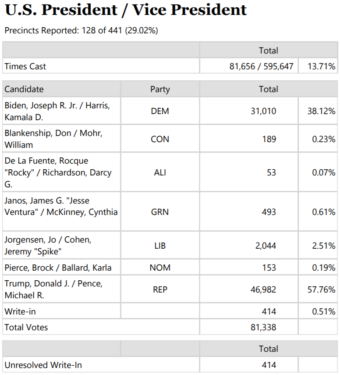
Several voters from around the state said the presidential race was a huge reason they came to the polls on Election Day.
For Jackson Pavitt, in Juneau, he said getting President Trump out of office was his main interest this election.
“I just think he’s kind of, not a great representative of our country. And I think he’s not a particularly great human being in general, we could do a lot better to run our country.”
Ketchikan voter Philip Boling said it was the most important race to him. He said he was excited and not worried about losing.
“The election is for our country. I mean, for freedom, freedom of speech, or especially on the internet, you know, it’s getting a lot of censorship and I believe that censorship is wrong, you know, both parties should have equal free right to speech,” he said. “And I think that’s a big part of what Trump is backing.”
Republican Sen. Dan Sullivan is in the lead over Independent challenger Al Gross, 58% to 37%, and Republican Don Young has a slight lead over Independent challenger Alyse Galvin, 58% to 41%.
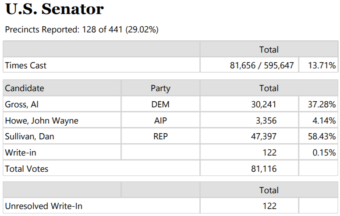
The results announced Tuesday night include nearly 40,000 early votes cast through Thursday as in-person results. But that leaves 123,000 early votes that arrived through Monday to be counted next week, as well as thousands more absentee and questioned ballots that hadn’t yet arrived.
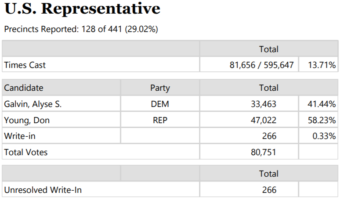
Juneau-area precinct chairperson Jack Chenoweth has been working in the Auke Bay precinct since 2010. He said he skimmed the voter rolls first thing in the morning and it appears that about half of the 2,000 registered voters in his precinct had already voted before he opened at 7 a.m.
And it was steady, but slow on Tuesday by 9 a.m.
“I think, in terms of turnout, it was largely offset by early voting opportunities that people had,” Chenoweth said.
In addition to the national races and state races, Alaskans have two ballot measures to decide.
Early results show oil tax initiative Ballot Measure One — dubbed the “Fair Share Act ” by its sponsors — is currently down with slightly over 60% of the votes reported cast against it.
And no votes on Ballot Measure 2 hold a slight lead over people voting in favor of it. That ballot measure would overhaul the state’s elections.
Initial results in state Supreme Court Justice Susan Carney’s retention election, which saw a conservative coalition campaigning against Carney, showed the justice ahead 60% to nearly 40%.
Stephen Eshnaur of Juneau said the judges on the ballot are his main concern, this election and every election.
“I actually believe that the judicial branch of government is the most dangerous,” Eshnaur said. “Because their decisions basically affect a generation. Maybe up to three generations for their decisions. So, that’s why I never want to retain a judge.”
Because Alaska is the last state in the country to begin to count absentee ballots, the outcome of close races won’t be known for at least a week after Election Day.
Alaskans line up at polls as large number of absentee ballots wait to be counted
By Andrew Kitchenman, KTOO and Alaska Public Media
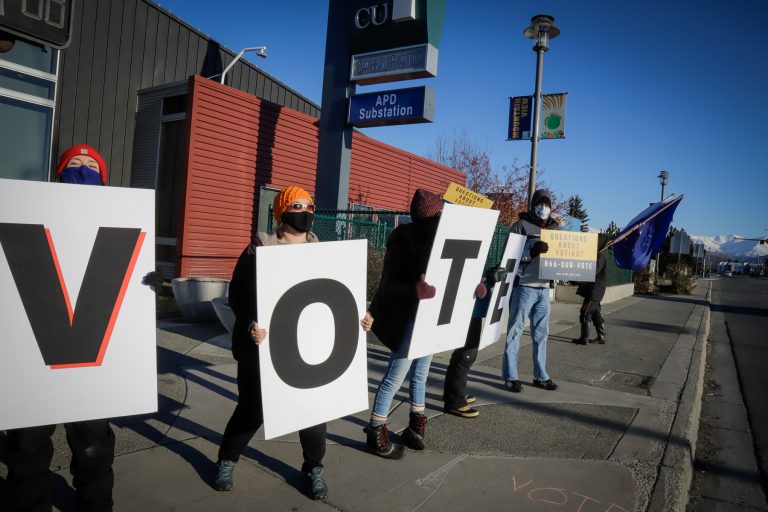
There were long lines at polling places across Alaska on Tuesday, despite more votes being cast early and by mail than in the past.
There were more than 161,000 votes cast absentee or early through Monday in the state. That total is more than half of the total number of Alaska votes cast in the 2016 presidential election.
The Alaska Division of Elections reported in-person turnout at a sampling of 15 of the 441 precincts around noon on Tuesday. Turnout was a little less than a third of the total turnout in the last presidential election. But since it was only a third of the way through the day, it wasn’t far out of line with previous years.
Division of Elections Director Gail Fenumiai expressed hope on Monday that there would be in-person voting in every community. She noted one exception; Clark’s Point community members said they wanted no in-person voting. So the division provided the community with absentee ballots.
By late afternoon, there were scattered reports of problems at polling places statewide, but no large-scale problems. It remained to be seen if more problems would emerge in the evening or after polls close.
While news outlets are reporting high turnout nationally, the turnout in Alaska won’t start to become clear until in-person results are reported on Tuesday night. It’s not yet known whether the unprecedented number of absentee and early votes represent more voters than in the past, or whether people who already planned to vote moved up when they voted.
All absentee ballots — as well as those in-person early votes cast after Thursday — won’t start to be counted by the Division of Elections until next Tuesday, Nov. 10. The division faces a deadline of Nov. 18 to count absentee ballots.
Alaska is the last state in the country to begin counting absentee ballots. Fenumiai defended Alaska’s slower approach.
“The division believes the legal requirement of one person, one vote takes priority over counting ballots quicker,” she said.
The state uses that time to ensure that none of the absentee ballots were cast by people who also voted on Election Day.
State law says elections officials “shall” start counting absentee ballots at 8 p.m. on Election Day. Fenumiai said on Monday that the law means that the state can’t start counting absentee ballots before 8 p.m.
“Duplicate voting is prohibited by statute as well, so we will not know whether the ballot should be counted and is eligible to count until the duplicate research has occurred,” she said.
The results announced on Tuesday night will include 37,995 early votes cast through Thursday, as well as the in-person results from Thursday.
That still leaves roughly 123,000 early votes that had arrived through Monday to be counted next week, as well as thousands more absentee and questioned ballots that hadn’t yet arrived.
KTOO will report on results on Tuesday night, from 9 p.m. to 11 p.m. It will be streamed on ktoo.org/listen.


